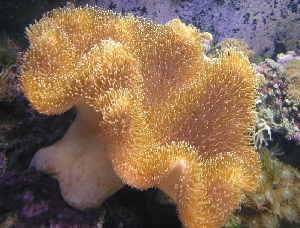These corals are very resilient and can adjust to different setups with medium to high lighting and moderate flow.
Submitted by Aquarium Advice member Fluff
Synonyms: S. ehrenbergi, S. elegans, S. glaucum, S. trocheliophorum and many others
Common Names: Toadstool coral, leather coral, mushroom leather coral, trough coral
Category: Soft coral
Family: Alcyoniidae
Origin: Indo-Pacific
Main Ecosystem: Marine
Salinity: 1.023-1.025
Temperament: Docile
Diet: Plankton, symbiotic algae (zooxanthellae)
Care: These corals are very resilient and can adjust to different setups with medium to high lighting and moderate flow. They aren’t as tolerant of high flow areas. Very little care is involved since they can get a lot of their nutrients from the saltwater itself, as well as the ability to make zooxanthellae from the lights. This is a fast-growing coral that gets pretty large. Be sure when deciding on placement that you give it plenty of room. Sarcophyton species are a peaceful coral in that they don’t reach out and attack neighboring corals like some lps will, but they are toxic and can harm neighboring corals through chemical warfare. This coral is capable of movement, albeit very slow, by detaching and reattaching its base.
Sarcophyton has the ability to shed its outer layer to rid itself of accumulated algae and debris and may look sickly during this process. Adding water flow during this process will help in aiding the coral to complete the shed. I help this along by gently blowing the coral with a baster.
Fragging this coral is super easy and a frag will reattach and form a new coral fairly quickly. This coral can be fragged many ways. Cutting off the crown will give you two corals. Taking the cap/crown and slicing it can gain you many corals. There is very little risk involved and almost any cut will create new colonies. The frags can then be attached using glue or rubberbands. I’ve had successful attachments just by placing part of it in a small hole in the liverock.
pH, float the bag in your main tank to acclimate to temperatures before adding the coral.
Breeding: These corals do not reach sexual maturity for years and need to be of substantial size. A male coral, 6-8 years old, attains a size of around 4 x 4 x 4″. Females are much larger and don’t reach maturity until they are 8-10 years old and 24 x 24 x 24″. They also reproduce by budding, fragmentation and stolons.
Comments: This is a great coral for beginners and is very forgiving. They are very hardy and can adjust to lots of different types of tanks. Just keep in mind these corals grow fast and can get quite large. They are not the best choice for smaller tanks.
Sources:
Waikiki Aquarium
http://waquarium.mic.hawaii.edu/MLP/root/html/MarineLife/Invertebrates/Cnidarians/LeatherCoral.html
http://www.liveaquaria.com/product/prod_Display.cfm?pCatId=753
Aquarium Corals book by Eric Borneman

